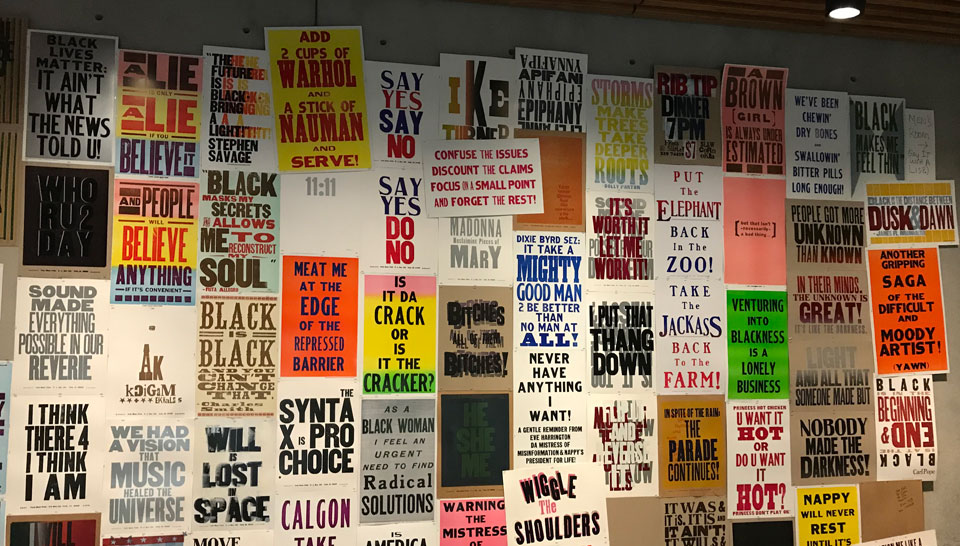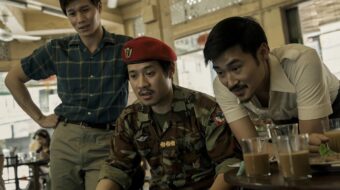
CHICAGO—Bookending my trip to the Windy City to attend the CPUSA convention, I made time for some museum visits. I can highly recommend three exhibitions that I managed to tuck in.
About Face: Stonewall, Revolt, and New Queer Art
This one, at the recently opened museum called Wrightwood 659, after its address, is stunning and revelatory—impressive as well for the remarkable transformation of a 1920s redbrick apartment building into a modern four-story gallery designed by Pritzker Prize-winner Tadao Ando. The building itself is a magnificent statement. Your time here will be generously rewarded.
The curator of About Face is Jonathan David Katz, Ph.D., visiting professor of gender, sexuality and women’s studies at the University of Pennsylvania and chair of the doctoral program in visual studies at the University at Buffalo. The show will be on view through Aug. 3, 2019. Chicago residents and visitors are urged not to miss it!
In the words of the curator:
“This is an exhibition about metamorphosis. Fifty years after Stonewall, we’re still very much a community in progress. The traditional view, that Stonewall represents the birth of a gay and lesbian movement, couldn’t be further from the truth on at least two counts: it hardly represents the beginning and it was never just gay and lesbian. On the contrary, we have always embraced a trans politics, in the sense of working to variously transgress, transfigure, transpose, transform, and finally, transcend a world of binary options, whether they be gay/straight, male/female, minority/majority, or conformist/nonconformist. Not for nothing were trans folk of various stripes the literal spark that ignited the Stonewall flame. This exhibition thus focuses on art in which boundaries blur, forms mutate, the natural is denaturalized, and the transgressive and transcendent are linked. In the works on view in About Face, sexuality, gender, ethnicity, and race—far from being clear categories—hybridize and overlap to the point that ‘queer’ becomes a verb, not a noun.”
Katz adds that “this new queerer world isn’t about creating a more modern, stable identity, but the perpetuation of a continuously hybrid one, a recognition that we are all an amalgam of many identities, that the problem with ‘identity politics’ is that it’s written in the singular. This recognition was modeled in art long before it could be brought to life.”
The artists featured in About Face are a diverse group originating from Colombia, India, Cuba, the UK, Sweden, South Africa, China, France, Indonesia, the United States, and Canada. I would add Argentina, but I will explain.
The artists Katz has included area are Carlos Alfonzo, Ralph Arnold, Shimon Attie, Amos Badertscher, Joan E. Biren, Rashayla Marie Brown in collaboration with Brianna McIntyre, Roger Brown, Jerome Caja, Nick Cave, Tianzhuo Chen, Patricia Cronin, John Dugdale, Bob Faust, Gilbert & George Maria Elena Gonzalez, Hervé Guibert, Harmony Hammond, Keith Haring, Lyle Ashton Harris, Sharon Hayes, Richard Hofmann, Peter Hujar, Bill Jacobson, Deborah Kass, Greer Lankton, Attila Richard Lukacs, Harvey Milk, Kent Monkman, Carlos Motta, Zanele Muholi, Alice O’Malley, Carl Pope, Marlon Riggs, Jacolby Satterwhite, Leonard Suryajaya, Gail Thacker, Keijaun Thomas, Arthur Tress, Del LaGrace Volcano, Sophia Wallace, and Martin Wong.
I have written in People’s World about my late partner Rick Barnett, who was a New York gallery director and curator in the 1980s. It’s where we met in 1986. He knew several of the featured artists in About Face, represented them in galleries, and acquired works by several of them. After he died, I inherited them. The exhibition includes a group of photographs by the late Peter Hujar. One is captioned as “a man” painting a mural on the New York piers, a popular cruising spot at the time. But I knew that man, and own a couple of his works. He painted in an unmistakable style characterized by armless classical torsos. His name was Luis Frangella (1944-90) and he was from Argentina.

As it happens, Rick’s sister Sandy lives in Chicago, and I paid her a visit Sunday afternoon after the convention. She owns a couple of Frangellas also. I photographed both hers and mine and emailed them to the Wrightwood curatorial staff. So a PW journalist’s assignment to a queer art show unexpectedly solved a little mystery buried in Peter Hujar’s oeuvre, restoring a significant name to the pantheon.
As Katz says, queer art did not start with Stonewall. Among American artists, we can count forerunners such as Romaine Brooks, Marsden Hartley, Paul Cadmus, and almost certainly Thomas Eakins. Yet after Stonewall, artists felt a new spirit of exhilaration and freedom and expressed it in the multimedia formats we see here. There is a sudden irrepressibility of lust and desire, rejection of bourgeois patriarchy, confrontation, and demand, as well as, starting in the early 1980s, the poignant, urgent need to document and to be remembered in the face of premature death.
Among the artists I did not anticipate seeing was Harvey Milk (1930-78), mostly known for his political and community leadership. But as the owner of a camera shop in San Francisco, he was also an avid art photographer himself. His work here elegantly captures some of his friends, and presumably lovers.
Martin Wong (1946-99), a Chinese-American painter, was drawn to depict the gritty urban environment populated by beefy firemen and prisoners. He often incorporated American Sign Language in his frames to broaden his horizons of communication. Joan E. Biren has long documented the lesbian community with her unabashed group nude studies shown in About Face. Deborah Kass is represented by large colorful pop art canvases featuring stylized lettering.

Set aside at least a couple of hours for this stimulating show.
Wrightwood 659 is located at 659 W. Wrightwood, Chicago 60614. Their phone number is (773) 437-6601. For complete information as to directions, hours, related programming, and ticketing, go to https://wrightwood659.org.
At the Art Institute of Chicago
Robert, my host in Chicago, who introduced me to Wrightwood 659, was saving up his visit to the Art Institute so that we might enjoy together the temporary exhibition, Manet and Modern Beauty, which runs through Sept. 8, 2019. The show focuses on the later years of Manet’s unfortunately shortened life. He died in 1883 at 51, appreciated among his fellow artists and collectors, but largely unheralded by the fussy arts establishment of his time. It’s almost unbelievable today that he had not been lionized in his own day, but the fact is that his fame is largely posthumous, spurred by retrospectives at the Ecole des Beaux-Arts in 1884 and at the Exposition Universelle in 1889.
Manet is known for his images of Parisian café and street life, the women with their fashionable dresses and coquettish bonnets, the men with top hats. Yet he did not ignore the middle and lower classes either. One critic was left appalled by Manet’s “vulgar, frightful types”—meaning drinkers, smokers, barmaids, and working-class beer-quaffers. He was clearly not simply an esthetic captive of the bourgeoisie.

No mention of Manet would be complete without reference to his large-scale paintings from 1867-69 depicting the imperialist French intervention in Mexico, specifically his three versions of the Execution of Emperor Maximilian. (The Mexican army’s defeat of the French during one battle at Puebla is commemorated annually as Cinco de Mayo.) Maximilian, a Habsburg “emperor” who had been installed by Napoleon III, is shown being shot by a Mexican firing squad in a scene reminiscent of Goya’s war paintings. The idea that a French painter would commemorate such a scene was deemed unacceptably unpatriotic, and neither the paintings nor a lithograph of the subject were permitted to be shown in France.
In January 1871, Manet traveled to the Pyrenees, far from home, where he missed the historic Paris Commune that spring. Although he did not voice open support for the Commune, he did hold bourgeois politicians in contempt. But neither did he ignore the Commune in his art. He painted a watercolor/gouache, The Barricade, depicting a summary execution of Communards by Versailles troops—not entirely original, however, as he based it on his image of the execution of Maximilian. He also painted The Barricade in oil on plywood.
Manet and Modern Beauty focuses on his late years, from the late 1870s until his early death from the effects of syphilis and rheumatism. Until this exhibition, there had never been such a gathering of the late works. Didactics on the walls indicate that the Art Institute drew from numerous museums and collections on several continents.
In severe recurring pain from his illnesses in these late years, Manet rarely traveled far. The period of painting historical statements was over, and he turned his attention to the here and now—portraits of visitors to his rented country homes in the summer, tightly cropped “café scenes” that he could stage at home with a few simple props, garden studies, and intimate paintings in pastel and watercolor of flowers and fruits in all their gaiety and variety.
Through his maladies, he disciplined himself with daily dedication: “To distract myself and even to feel really well, I’d have to be working.”
Seeing this work close up is important to appreciate Manet’s place in art history. While he did not identify himself with the new Impressionists, they included him in their ranks against the stodgy Salon as a fellow rejectee of its annual exhibition of work they approved. Regarded as more of a realist, Manet nevertheless incorporated many Impressionist techniques on his canvases. Turn away from the more carefully modeled face and see that the billows of clothing, the curtains, the foliage, the distant horizon are often a spontaneous riot of almost pure fluid abstraction. As such, he is possibly the most significant transitional figure in the latter part of the 19th century.
Anti-Apartheid poster art
Also at the Art Institute now, running through Sept. 2, 2019, is The People Shall Govern! Medu Art Ensemble and the Anti-Apartheid Poster. Visitors especially interested in political art might be advised to start here, as there is much to see, well over 100 pieces, each with its distinct subject matter, time, place, and even language.
The Medu Art Ensemble formed in the late 1970s in opposition to South Africa’s apartheid policy of racial segregation and violent injustice. Through graphic design and poster production, members forcefully articulated a call for radical change, advocating for decolonization or majority (nonwhite) rule in South Africa and in the neighboring countries of Angola, Mozambique, Namibia, and Zimbabwe.
Medu, meaning “roots” in the Sepedi language, evolved organically and operated underground, as its name suggests. Persecuted by the South African Defense Force, Medu members lived and worked in exile just minutes across the South African border in Gaborone, Botswana.
Botswana had achieved its independence smoothly in 1966—which did not prevent the apartheid authorities from bombing and raiding the country. Defying a ban on their existence, the Medu collective at its height numbered as many as 50 South African and international artists, musicians, and writers. The movement was mostly allied with the African National Congress (ANC).
In July 1982, Medu organized an international symposium of political artists in Gaborone which attracted 1000 activists and cultural workers. A Dutch film crew created a documentary of that week, Saying No, Gaborone, which is on view in the gallery. In 1985 the South African Defense Forces raided the Medu headquarters there, killing 12, and destroying its stockpile of art. Medu ceased its activities after that.
After the successful independence movements assumed power in Angola and Mozambique, those Portuguese-speaking countries created their own artistic collectives producing propaganda, also providing refuge for South African exiles.
Though most of the Medu members were male, they paid special attention to including women in their imagery if they intended it to be an effective motivator to action.
The People Shall Govern! is the first-ever exhibition on Medu in North America. Featured are more than 60 posters by members of the ensemble and related makers, all recently acquired by the Art Institute of Chicago. Collaboratively executed and often printed in the hundreds, Medu’s offset lithograph and screen-printed posters combine sobering and revolutionary imagery with bold slogans that, in word and image, mobilized citizens to support causes in social and economic justice and encouraged pan-African solidarity.

This imagery inspired anti-colonial movements and the artists affiliated with them throughout the world. People who saw this work on posters and flyers might not have been aware of the original African esthetics from which they derived.
Surviving examples of Medu posters that were smuggled into South Africa and mounted in public spaces are exceedingly rare, as they were regularly confiscated or torn down on sight. With this recent acquisition, the Art Institute is home to the most comprehensive holding of these vibrant works outside South Africa. Additional items, on loan for this exhibition from former Medu members and archival sources in South Africa and Chicago, make clear how the Medu spirit of oppositional creativity transformed the culture of resistance in southern Africa during the late 20th century.
The Art Institute of Chicago is located at 111 S. Michigan Ave, Chicago 60603. For hours and other information, click here. The customer service number is (312) 443-3600.
Sources: Wrightwood 659 and the Art Institute of Chicago.












Comments